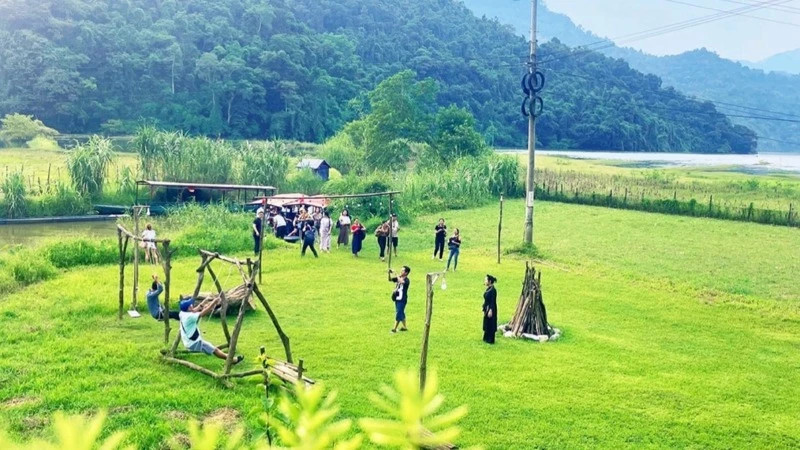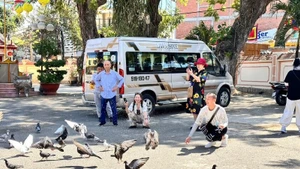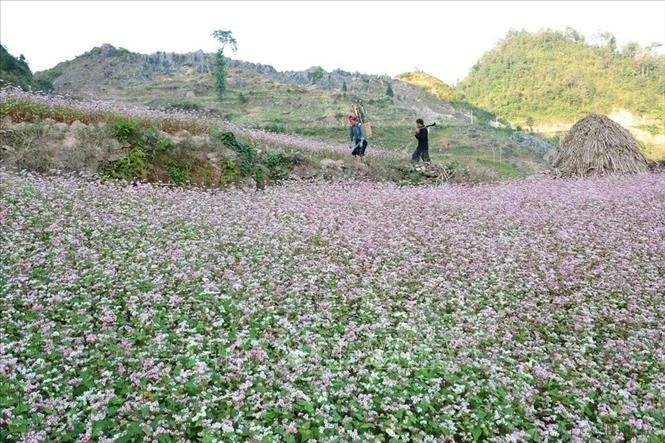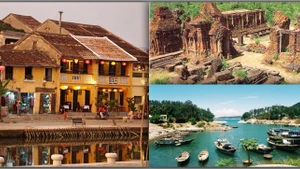Located nearly 7 km from Bac Kan City, Phieng An Village in Quang Thuan Commune, Bach Thong District, is home to predominantly Dao ethnic people, accounting for nearly 90% of the population, with the remainder being Tay, Nung, and Kinh ethnic groups. Phieng An is blessed with picturesque rivers and streams, expansive green tea hills, and delicious local fruits.
Visitors to Phieng An will cross a timeworn suspension bridge and stroll along clean, scenic paths flanked by lush tea plantations and fresh air. The tranquil atmosphere, bountiful fruit gardens, and rustic, simple homes captivate visitors.
Nguyen Van, a tourist, shared his impressions: “I was amazed when I visited Phieng An in winter. The air is fresh, and everything here feels so comfortable. The locals are becoming more professional in the welcoming of visitors. With proper investment and long-term strategies, I believe Phieng An will become a very unique tourist destination.”
Ban Huu Thanh, Secretary of Phieng An Village Party Committee, noted that the village has consistently been recognised as a cultural village for many years. All households have achieved the title of Cultural Family, public security has been maintained, and the spirit of community cohesion is strongly upheld. Over the past 20 years since the Dao people settled in Phieng An, their living standards have significantly improved.
Despite modernisation, the Dao people continue to preserve their unique cultural values, including their traditional clothing, language, and customs, which they integrate into daily life and production. These cultural features are a significant draw for visitors exploring Phieng An, a serene and poetic countryside rich in cultural identity. However, Phieng An still lacks distinctive tourism products and community lodging facilities to encourage longer stays.
Similarly, in Chua Lai Village, 25 km from the centre of Cho Moi District, the Tay ethnic people make up 90% of the population. Thanks to rural development efforts, transportation to the village has improved significantly following infrastructure upgrades. One of Chua Lai’s standout attractions is its 12 ancient stilt houses, which exude the cultural essence of the Tay people.
During festivals and traditional holidays, locals don traditional attire, sing folk songs such as Sli, and prepare traditional dishes. Duong Van Hoan, Deputy Chief of the Bac Kan New-Style Rural Area Coordination Office, highlighted that harmoniously combining agricultural production with tourism development not only provides visitors opportunities for relaxation, physical and mental activities, and agricultural experiences but also shifts the economic structure from pure agriculture to integrated services, generating practical benefits and increasing rural incomes.
The synergy between agriculture and tourism also promotes local agricultural products and introduces new, eco-friendly tourism offerings. To date, Bac Kan has 28 communes meeting new-style rural areas standards and four communes meeting advanced new-style rural areas standards. The province is focused on building new-style rural areas in challenging regions, particularly in areas with ethnic minorities and impoverished districts, aligning with the National Target Programme for Socio-Economic Development in Ethnic Minority and Mountainous Areas for the 2021-2030 period.
Given Phieng An’s potential, the provincial People’s Committee plans to invest in a pilot model for rural tourism linked to new-style rural area development as part of Bac Kan’s 2021-2025 development scheme. This project aims to enhance the village’s infrastructure, including building product exhibition houses, parking lots, public restrooms, entrance gates, and directional signage. It also plans to create walking paths for visitors to explore local fruit gardens and tea plantations.
However, the reality is that community-based tourism in Bac Kan is still in its infancy, with limited experience. Provincial investment in this sector remains modest, and the capacity to attract socialised resources is low. Large-scale investors with substantial financial resources and long-term strategic vision have yet to be drawn to the area.
Most residents belong to ethnic minorities and follow a subsistence lifestyle, with limited exposure to the tourism market. There is also hesitation in transitioning from traditional agricultural production to tourism services. Rapid urbanisation in Bac Kan Province further impacts community-based tourism development.
To sustainably develop community-based tourism with linkage to new-style rural development in Bac Kan, local authorities and relevant agencies must prioritise infrastructure and auxiliary facility development to attract more tourists, extend their stays, and increase their spending and likelihood of returning.
Community-based tourism development should be closely tied to creating unique agricultural products and handicrafts that reflect the local identity. These efforts can attract tourists and encourage them to engage with and consume local offerings. When implementing the “One Commune, One Product” programme, each district, town, and city should focus on supporting the production of distinctive agricultural products and leveraging these advantages to advance community-based tourism.
















